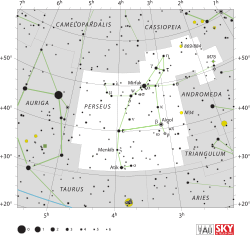Zeta Persei

Location of ζ Persei (circled) | |
| Observation data Epoch J2000 Equinox J2000 | |
|---|---|
| Constellation | Perseus |
| Right ascension | 03h 54m 07.92248s[1] |
| Declination | +31° 53′ 01.0812″[1] |
| Apparent magnitude (V) | 2.86[2] |
| Characteristics | |
| Spectral type | B1 Ib[3] |
| U−B color index | –0.72[2] |
| B−V color index | +0.10[2] |
| Astrometry | |
| Radial velocity (Rv) | 20.1 ± 1.2[4] km/s |
| Proper motion (μ) | RA: +5.77[1] mas/yr Dec.: –9.92[1] mas/yr |
| Parallax (π) | 4.34 ± 0.19[1] mas |
| Distance | 750 ± 30 ly (230 ± 10 pc) |
| Details | |
| Mass | 14.5 ± 1.9[5] M☉ |
| Radius | 26–27[6] R☉ |
| Luminosity | 47,039[5] L☉ |
| Temperature | 20,800[5] K |
| Rotation | 2.9–17.3 days |
| Rotational velocity (v sin i) | 40[3] km/s |
| Age | 12.6 ± 1.5[7] Myr |
| Other designations | |
Zeta Persei (ζ Per, ζ Persei) is a star in the northern constellation of Perseus. With an apparent visual magnitude of 2.9,[2] it can be readily seen with the naked eye. Parallax measurements place it at a distance of about 750 light-years (230 parsecs) from Earth.[1]
This is a lower luminosity supergiant star with a stellar classification of B1 Ib.[3] This is an enormous star, with an estimated 26–27[6] times the Sun's radius and 13–16 times the Sun's mass.[6] It has about 47,000 times the luminosity of the Sun and it is radiating this energy at an effective temperature of 20,800 K,[5] giving it the blue-white hue of a B-type star.[9] The spectrum displays anomalously high levels of carbon.[10] Zeta Persei has a strong stellar wind that is expelling 0.23 × 10–6 times the mass of the Sun per year, or the equivalent of the Sun's mass every 4.3 million years.[11]
Zeta Persei has a 9th magnitude companion at an angular separation of 12.9 arcseconds. The two stars have the same proper motion, so they may be physically associated. If so, they are separated by at least 4,000 Astronomical Units.[12] Zeta Persei is a confirmed member of the Perseus OB2 association (Per OB2), also called the Zeta Persei association, which is a moving group of stars that includes 17 massive, high luminosity members with spectral types of O or B, giving them a blue hue. These stars have a similar trajectory through space,[4] suggesting they originated in the same molecular cloud and are about the same age.[13]
See also
- Druuge, a fictional race from the 1992 computer game Star Control II whose home world is a planet orbiting Zeta Persei.
References
- ↑ 1.0 1.1 1.2 1.3 1.4 1.5 van Leeuwen, F. (November 2007), "Validation of the new Hipparcos reduction", Astronomy and Astrophysics 474 (2): 653–664, arXiv:0708.1752, Bibcode:2007A&A...474..653V, doi:10.1051/0004-6361:20078357
- ↑ 2.0 2.1 2.2 2.3 Lutz, T. E.; Lutz, J. H. (June 1977), "Spectral classification and UBV photometry of bright visual double stars", Astronomical Journal 82: 431–434, Bibcode:1977AJ.....82..431L, doi:10.1086/112066
- ↑ 3.0 3.1 3.2 Abt, Helmut A.; Levato, Hugo; Grosso, Monica (July 2002), "Rotational Velocities of B Stars", The Astrophysical Journal 573 (1): 359–365, Bibcode:2002ApJ...573..359A, doi:10.1086/340590
- ↑ 4.0 4.1 Steenbrugge, K. C. et al. (May 2003), "Radial velocities of early-type stars in the Perseus OB2 association", Astronomy and Astrophysics 402: 587–605, arXiv:astro-ph/0302428, Bibcode:2003A&A...402..587S, doi:10.1051/0004-6361:20030277
- ↑ 5.0 5.1 5.2 5.3 Hohle, M. M.; Neuhäuser, R.; Schutz, B. F. (April 2010), "Masses and luminosities of O- and B-type stars and red supergiants", Astronomische Nachrichten 331 (4): 349, arXiv:1003.2335, Bibcode:2010AN....331..349H, doi:10.1002/asna.200911355
- ↑ 6.0 6.1 6.2 Pasinetti-Fracassini, L. E. et al. (February 2001), "Catalogue of Stellar Diameters (CADARS)", Astronomy and Astrophysics 367: 521–524, arXiv:astro-ph/0012289, Bibcode:2001A&A...367..521P, doi:10.1051/0004-6361:20000451
- ↑ Tetzlaff, N.; Neuhäuser, R.; Hohle, M. M. (January 2011), "A catalogue of young runaway Hipparcos stars within 3 kpc from the Sun", Monthly Notices of the Royal Astronomical Society 410 (1): 190–200, arXiv:1007.4883, Bibcode:2011MNRAS.410..190T, doi:10.1111/j.1365-2966.2010.17434.x
- ↑ "zet Per -- Variable Star", SIMBAD (Centre de Données astronomiques de Strasbourg), retrieved 2012-01-12
- ↑ "The Colour of Stars", Australia Telescope, Outreach and Education (Commonwealth Scientific and Industrial Research Organisation), December 21, 2004, retrieved 2012-01-16
- ↑ Jaschek, M.; Jaschek, C. (December 1974), "The CNO stars", Astronomy and Astrophysics 36 (3): 401–408, Bibcode:1974A&A....36..401J
- ↑ Morel, T. et al. (June 2004), "Large-scale wind structures in OB supergiants: a search for rotationally modulated Hα variability", Monthly Notices of the Royal Astronomical Society 351 (2): 552–568, arXiv:astro-ph/0403155, Bibcode:2004MNRAS.351..552M, doi:10.1111/j.1365-2966.2004.07799.x
- ↑ Burnham, Robert (1978), Burnham's celestial handbook: an observer's guide to the universe beyond the solar system, Dover books explaining science 3 (2nd ed.), Courier Dover Publications, p. 1422, ISBN 0-486-23673-0
- ↑ de Zeeuw, P. T. et al. (January 1999), "A HIPPARCOS Census of the Nearby OB Associations", The Astronomical Journal 117 (1): 354–399, arXiv:astro-ph/9809227, Bibcode:1999AJ....117..354D, doi:10.1086/300682
External links
- Kaler, James B., "Zeta Persei", Stars (University of Illinois), retrieved 2012-01-12
| ||||||||||||||||||||||||||